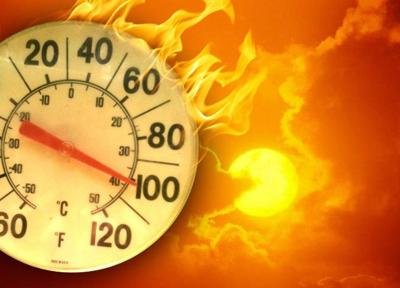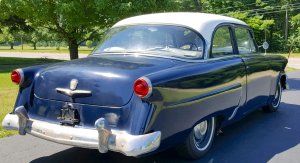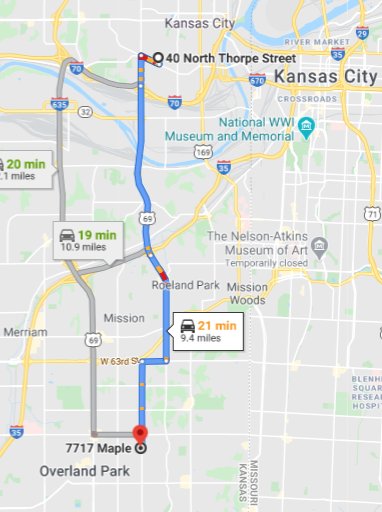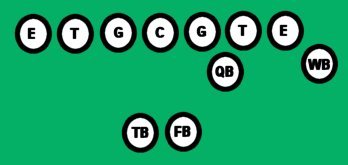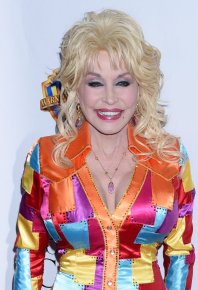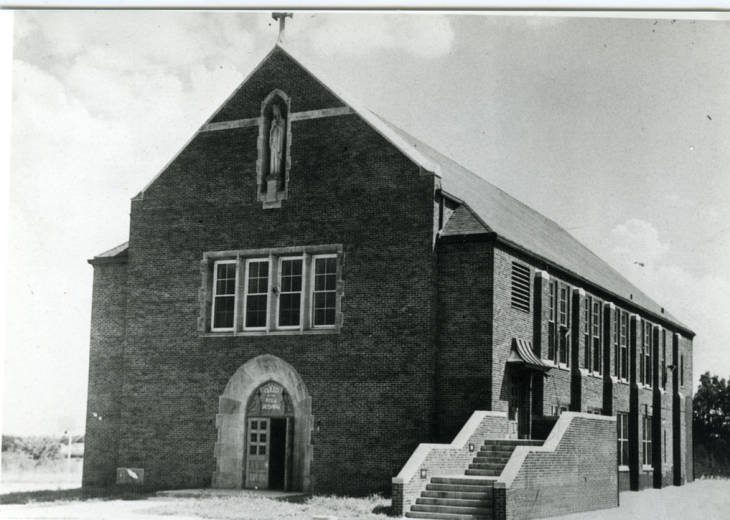My early days in KC KS. Continue reading
My parents told me that it was over 100° when I was born in St. Luke’s hospital in Kansas City, MO, on the afternoon of August 17, 1948. I was two days overdue. I have always claimed that I stayed inside until it was warmer outside. My recollection is that my parents told me that I weighed seven pounds and eleven ounces. In most respects I was quite healthy. My eyes were what people call hazel—brown in places, green in places, some other colors, and changeable. My hair, when it arrived, was a very dark color that matched that of both of my parents.
I lived the first twenty-two years of my life in the KC area, but on the west side of the Missouri River and State Line Road, i.e, in Kansas, the Sunflower State. I have almost no memories at all of my first four years. Since I spent those years in and out of hospitals, it might be a blessing. I was born with a cleft lip, which the doctors fixed with a series of operations that in those days were quite novel. I will spare you pictures of what people with this condition look like.
Fortunately for the family, my dad worked for an insurance company that provided health insurance for all its employees. I am certain that my parents and grandparents would have done anything that they could for me anyway, but it would definitely have entailed some hardships. When I was little, we did not have much money.
I have retained only two memories of being in the hospital during that period. I recall a plastic toy tank that someone gave me. A rubber dart could be mounted on its gun barrel. There was also a round semi-spherical rubber piece on the top of the tank. When you pressed on it the dart went flying. I loved it.
The other memory is shorter but less pleasant. I vaguely remember being strapped down in my bed. Somehow I had become dehydrated. The family legend relates that my grandmother, Hazel Wavada, could see that something was wrong with me, and she raised hell until the hospital staff addressed the problem by pumping me full of something. To this day the only phobia from which I suffer has to do with needles. If you see me with a tattoo or a piercing, you will know that aliens have taken control over my mind.
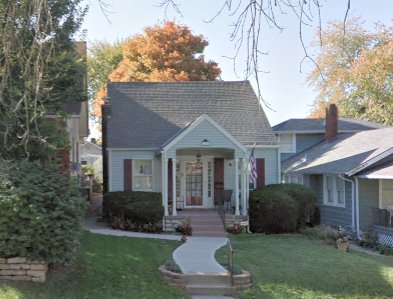
We lived in a house owned by my maternal grandparents, John and Clara Cernech1. I don’t remember them ever living with us, but they might have when I was an infant. A man whom I called Uncle Richard did live with us. His last name was Keuchel (rhymes with cycle), which indicates that he was related to Clara. He might have been her brother—Clara had lots of brothers and sisters. He might have been a cousin.
I am pretty sure that, as my dad would say, we didn’t have two nickles to rub together. We did not have a car or modern appliances, but I certainly never felt deprived.
I can still rather easily visualize parts of the house. I had my own tiny bedroom. My most precious possession was a green cowboy blanket, which I dragged around with me. I kept one of the corners between my right forefinger and middle finger. I named the four corners after political figures. Those areas were all worn out. My favorite was Adlai Stevenson, my dad’s political hero.
The basement was a spooky place. There was a coal chute. I have no idea how the coal got into the heater or from the street. I can hardly imagine my dad shoveling it. Maybe we no longer used coal. I also remember a washtub with a wringer. Later my dad and Joey Keuchel2 built a rather elaborate train set on two or more ping-pong sized tables. This was supposedly mine, but they messed with it much more than I did. When our little family moved south, the train accompanied us, but not the tables. We never set it up at our new house.
I remember the kitchen as a very wholesome place. My mother painted an apple tree on one of the walls, and she did a very good job. I have no absolutely no artistic taste, but everyone complemented her on her work.
I sometimes went to the store with my mother. How did we get there? We must have walked most of the time. There were “street cars”, which is what the locals called trolleys, and buses, but I have only vague memories of either one. Central Ave., a main drag was only two blocks from the house.
KC KS used a monetary currency that I have nowhere else encountered, plastic coins called “mills”. My recollection is that the green ones were worth one tenth of a cent, and the red ones were worth half a cent. I might have this backwards. They were used for sales tax.
I have a few other vivid memories of those years. I had two friends, Larry Boatman and David Milgram. They were both about my age, but I do not remember going to kindergarten with them. I think that David might have been visiting (or even lived with) his grandparents, who lived next door. There was a third kid whose birthday was the same as mine. He lived in the house directly across the back alley from ours.
There were no girls in my age group in our neighborhood. At least I have no memory of any. It is quite possible that I just ignored them.
I was called Mickey, probably after Mickey Mantle, who played for the Kansas City Blues before the Yankees called him up. My dad told me that he once saw him hit two homers in one game—one right-handed and one left-handed.
One day I announced that I would no longer be called Mickey. The other kids had been taunting me: “Mickey Mickey Mickey Mouse; when he grows up he’ll be a rat.” Thereafter I was Mike Wavada.
We had a black and white dog named Trixie. I think that she was a terrier. I don’t remember much about her except that she could really jump. She might have been my mom’s dog. She must have died before we moved to the suburbs.
Before I was old enough for school my parents enrolled me in speech lessons. Despite my rather severe birth defect, I can never remember anyone having trouble understanding my speech. I am not sure that I actually needed the speech classes. At any rate I aced them. I was awarded a sticker depicting a hippopotamus for reciting my assignment well. Because “hippopotamus” was considered a difficult word to pronounce, the hippo sticker was highly valued.
I cannot remember much of the pre-television years. A family legend persisted for years about the occasion on which my parents and I were all attending mass at St. Peter’s cathedral. At some point I got bored and started complaining vociferously about the fact that I was missing the Lone Ranger.
I played by myself a lot. I remember that my mother made a train for me consisting of cardboard boxes. I had a cylindrical toy box, but the only one that I remember was a stuffed dog named Timmy. He was all black and had floppy ears. I had a red tricycle, which my sister eventually inherited.
I recall that I enjoyed parading around the house using the lids to pots as cymbals. My dad bought me some baseball cards. He was upset when I traded Mickey Mantle for Vic Power.
Despite the presence of so many heathens there, my parents enrolled me at Prescott School, the local public school, for kindergarten. St. Peter’s, our parish, had a grade school, but no kindergarten. I do not remember my kindergarten teacher’s name. I think that I walked to school. It must not have been far. (If I remembered the name accurately, the school apparently no longer exists. My efforts to determine where it was failed.) Maybe a few of us walked together, or maybe my mother walked with me.
I don’t remember learning much in kindergarten except when to keep my mouth shut. I fondly recall that we each had a towel or blanket that we used at nap time. This instilled a napping habit that has served me very well for my entire life. I also remember making an imprint of my hand in clay, which someone painted dark green. It was on display in our house for quite a while.
One kid in our class was BAD4. In addition to other high crimes and misdemeanors, he threw rocks at the other kids at recess. Did we even have recess? Maybe it was after school or before.
The boys, of course, would never report him because of the sacred obligation of omertà that juvenile males seem feel instinctively. The girls may have reported him to the teachers; I don’t know. All I know that he was still at large.
Believe it or not, I was the biggest kid in kindergarten. One day I had had enough of the rock-thrower. After school I hid behind a bush past which I knew that he had to walk. When he approached, I sprung out and punched his lights out. Actually, I don’t remember the details. I may have only hit him once, and then he may have run away. The next day my teacher took me aside and told me that I must never do that again. I nodded agreement.
My recollection is that the teacher did not promote the other kid at the end of the year. He actually flunked kindergarten. I, on the other hand, passed with flying colors.The other kids were learning their letters at school, but I was learning to read and write at home. My mother took me with her on the streetcar or the bus to the library. There I got to pick out a book or two from the children’s section. I favored the ones about cowboys. By the time that I started first grade, I could read pretty well.
All my relatives are Catholics. There was never any question that I would go to St. Peter’s School for first grade. I walked there, too, but my recollection is that a group of us walked together. I think that some of the others were of the female persuasion.
I remember a candy store near the school. I seriously doubt that I often had any money for candy, but it is possible that Uncle Richard occasionally gave me a nickle or a dime once in a while.

My teacher in first grade was a nun; I don’t remember her name either. She was not as nice as my kindergarten teacher. Also, there were no daily naps, and the classes were at once boring and frustrating. We probably did some craft things that I don’t remember. I have always been incompetent at anything vaguely artistic.
The activity that I most clearly remember involved slates and boxes. The boxes contained small light green cardboard letters, maybe 1/2″ x 1/4″. The other kids’ boxes contained a few dozen, but mine had between four and five million. The teacher would write a word or a phrase on the blackboard. Each student’s job was to find the letters in their own personal box and to place them on their personal “slate”, which was actually a paper and cardboard arrangement that was the size of a standard sheet of paper with rows in which the letters could be mounted.
It was kind of like Scrabble, but the letters were smaller and in boxes. The problem was that the letters in my box would hide from me. Items have hid from me all of my life; I have never figured out why or how they did it. If you asked me to get a bottle of Worcestershire sauce from the fridge, I probably would not be able to find it even if you told me what shelf it was on. Other bottles always conspire to conceal it, or maybe the target bottle would don a disguise. Or both.
From my poor performance at this activity Sister Whatever concluded that I was dumb, and she informed my parents of this at a parent-teacher conference. I can almost hear my mother saying, “But sister, I know that he can read and write already. He does both all the time at home.”
This episode occurred in 1954. It was perhaps the only bad thing that happened that year. My dad must have gotten a big promotion because he bought a blue and white Ford. We had our own car!
The other big news in 1954 was that the hapless Philadelphia Athletics were moving to Kansas City. We were going to be a major league city!
My travails at St. Peter’s school were short-lived4. Early in 1955, while I was still in first grade, we moved south to Prairie Village. For the rest of the year I attended (or at least was enrolled at) Queen of the Holy Rosary School. My teacher was Sister Mildred, and she taught her students to read and write, not to extract clandestine letters from cardboard boxes.
1. The Cerneches moved to Grand Island, NE, at some point.
2. Joey Keuchel became, unbeknownst to me, a doctor who practiced in Tulsa. He died in 2014. His obituary can be read here. Click on “print”.
3. Note: in my day problem students were not diagnosed with ADD or ADHD. Instead they were considered “dumb” or “bad”.
4. If you read this sentence aloud, please pronounce the last syllable as a long “i”, like eye. The compound word means having a short life. If someone has short sight, everyone calls them short-sighted, not short-seen, right? The principle is the same. Yes, yes, I know that the dictionary prefers the short “i” pronunciation, but it is just because lexicographers tired of correcting the unwashed masses.

